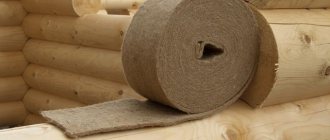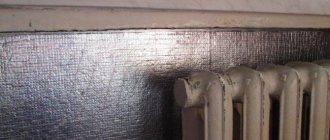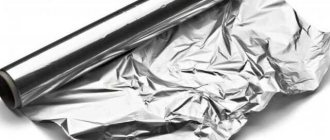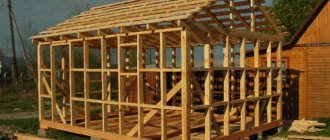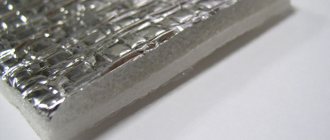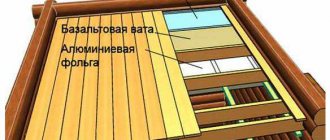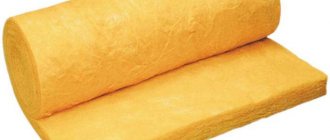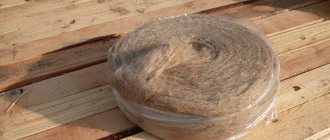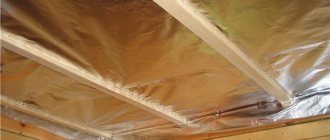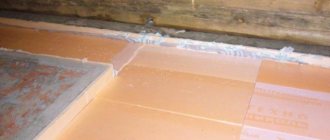High-quality thermal insulation, resistance to penetration of hot steam, high temperatures, resistance to moisture and external influences - this is foil insulation.
A thin aluminum layer reflects heat, keeping it inside the building. Such characteristics allow it to be used for installing insulation on the walls of baths and saunas.
Bath or sauna buildings require insulation and isolation from external influences. Internal insulation of walls from increased moisture, steam and high temperatures is also required.
A material is selected that is not susceptible to such influences - this is foil insulation for a bathhouse. Construction experts recommend this type of insulation.
Why do you need a foil layer?
Bath insulation with foil is called two-layer. It consists of an outer covering of a layer of aluminum foil, which is perfectly polished.
The metal coating reflects heat into the building, retaining over 95% of it indoors. This coating repels moisture and steam. The foil layer can withstand air heating up to +150°. The temperature inside the room increases by 2-4°.
The insulation base consists of foamed air bubbles, which prevents the conduction and absorption of heat.
Using foil to insulate baths
To determine which foil to use for a bathhouse is better, you need to take into account what material the structure is built from and the conditions of its operation. If the building is made of logs with carefully caulked walls, then it does not require foil insulation.
In the case where the bathhouse is built of natural wood, but is large in area and does not heat up well, experts recommend lining the ceiling and walls from the inside with thin foil, and then covering it with clapboard. You can use a foil sheet for the surface behind the heating unit, as a result of which the steam room will warm up faster.
Despite the fact that a bathhouse made of foam concrete is considered warm, it requires high-quality vapor barrier, so the use of foil will be justified, but it is better to opt for laminated products.
Frame and brick buildings must be insulated. Insulation for a bathhouse with foil based on polystyrene foam and mineral wool is ideal for this (read: “How to insulate a frame bathhouse - nuances from the master”). The type of this material is selected for ceilings taking into account the thickness of the ceiling and the absence/presence of thermal insulation in the attic.
In addition, operating conditions matter. If the bathhouse is used infrequently and the procedures are not carried out for long, there is no need to insulate it with foil. When the steam room is used frequently and is kept in it for a long time, high-quality thermal insulation will save fuel, and the room will quickly warm up and cool down for a long time.
Criteria for choosing foil for a bath
From the presented insulating insulation materials, a coating with foil paper is selected. The positive characteristics of bath foil are also taken into account.
To do this you will need a product that:
- protects against ultraviolet radiation;
- has additional moisture-proof and vapor-protective properties;
- thermal insulation;
- soundproofing;
- use on a variety of surfaces, including wood, concrete, brick;
- has dimensional characteristics.
Taking into account the building material from which the room is built, the thickness of the thermal insulation is selected. When choosing, they are guided by studying the number of positive reviews, checking quality indicators and certificates.
Attention is also paid to the condition of the packaging and its tightness.
Criteria for choosing insulation for a sauna
The insulation must withstand high temperatures and humidity.
When choosing the optimal insulation for a bath, you should focus on the basic requirements for the material:
- coefficient of thermal conductivity;
- presence of a reflective layer;
- moisture resistance;
- working temperature;
- thickness;
- flammability.
The specificity of a sauna with high humidity and temperature requires paying attention to the quality of the material. Difficult conditions negatively affect the insulation, reducing its service life. Manufacturers take into account the requirements for thermal insulation of baths and create special series with appropriate markings. An important factor is the absence of harmful emissions when heated. When purchasing insulation, you should read the manufacturer's information.
In bathhouses with wood-burning stoves, it is worth taking into account the flammability of the material. Basalt or mineral wool does not support combustion; polyethylene foam melts.
Types of foil and coating features
The walls of the bathhouse or sauna are insulated with aluminum-coated material, which retains internal heat. For this purpose, some types of protective layer are selected.
Folgoizol
Foamed polyethylene is the basis for a protective layer called folgoizol. Its thickness can be manufactured according to customer requirements from 100 microns to 200 microns.
The material can be rolled into soft rolls or presented in hard plates. The thickness of the insulated sheet is from 2 to 11 cm, length 25, 30 m with a width of 1 or 1.2 m.
Based on polystyrene, rigid plates have a thickness of 2 to 10 cm, size 60x120 cm. This type of insulation is used for application to the wooden walls of a log bathhouse, or to walls lined with clapboard.
The material is non-flammable and does not emit toxins at high temperatures. Environmental indicators allow the use of folgoizol in the food industry.
Protective aluminum layer, resistant to corrosion. Withstands temperatures up to +150 °. The operating period in comfortable conditions is more than 20 years.
Kraft foil
This type of insulation consists of three layers: a paper base (kraft paper), aluminum foil, and polyethylene in between. It functions as an additional water-repellent component and serves as an adhesive connector.
This material ideally protects the insulation from steam and moisture. Used to insulate the internal surfaces of baths and saunas. Without releasing toxins under the influence of high temperatures up to +120°. The joints are connected with aluminum tape.
Kraft aluminum coated foil is available in two sizes:
- 25 m long and 1.2 m wide;
- canvas 15 m of the same width.
Foil on a paper base for a bath is not subject to fire, reflects ultraviolet radiation well, and maintains the tightness of the surface.
Folar
Aluminum layer, fiberglass mesh and polyolefin film, glued together using polyurethane glue. A three-layer thick insulator is a folar.
The fiberglass mesh does not allow it to deform under the influence of high temperatures up to +150°, but retains high quality characteristics. The material is also environmentally friendly.
Foil mineral wool in soft rolls
A popular thermal insulation product on the Russian market is rolled mineral wool with a foil coating. Thermal insulation protects wooden bathhouse structures from the influence of steam and increased moisture.
High thermal insulation rates retain heat by 95%. Thanks to the protective base, the insulation belongs to the group of low-flammable materials.
The length of the canvas in a roll is 12.5 m, width 1.2 m with a thickness of 50 mm. The insulation is resistant to infection by mold fungi and damage by insect pests.
Performs the function of sound insulation. The lightweight material is used in any frame structures.
Might be interesting
Thermal insulation
How to insulate a roof from the inside and not make mistakes?
Thermal insulation
Roofing and drainage: heating rules
Thermal insulation
Insulated Swedish stove: pros and cons
Thermal insulation
Penoizol: self-production
Foil-coated mineral wool in the form of hard mats
Foiled layers of polystyrene foam are used in the form of hard mats. Used to cover water heated floors.
The polished surface screen reflects heat upward from the heating pipes. The applied markings help in the installation of the heating network.
Foil in rolls
Sauna foil on a soft base is used to maintain the thermal conditions of the room and is secured under the lining.
The joints are connected with special tape. The length of the canvas in a roll is 31 m ± 0.25 m, width 1.25 m, with foil 7 microns thick, cardboard density 50 g/cm³.
The thickness of the layer has high thermal conductivity. It is used as an insulated layer in steam rooms, applied on top of the insulation.
Types of reflector and its performance characteristics
There are several options for foil reflectors, which are usually used when arranging a modern steam room. Let's consider which of them are used in practice, which ones have operational features.
Material on a high-quality basis PHOTO: alibaba.com
Kraft foil “Izolar”: what kind of material, its characteristics
Kraft foil is a type of aluminum sheet. It is made with a seal, which makes its structure simpler. Differs in the following technical features:
- environmentally friendly material;
- insulator thickness - 0.03-1.0 mm;
- operating temperature - 100ºС;
- reflectivity - 95%.
This variation of material is very convenient for installation. It is characterized by increased strength compared to ordinary foil, which does not have a base.
Usually the material has a pimpled base. Occasionally a smooth reverse side is used PHOTO: m.bud.inforico.com.ua
Foil fabric as a thermal insulation option
Foil fabric is a special structured foil. It is intended for installation in the ceiling area of the steam room. The material is based on thermal fabric and aluminum foil. Characteristics include:
- width - 100 cm;
- foil thickness - 11-35 microns;
- operating temperature - up to 500ºС;
- Suitable for replacing fiberglass.
When heated, this material does not emit toxic substances or unpleasant odors.
Supplied for sale in large tubes of several hundred linear meters PHOTO: russian.alibaba.com
What is rolled foil?
As a rule, rolled foil does not have a reinforcing base. This is a fairly thin material that is easily torn and deformed. Its technical characteristics are:
- thickness - 0.007-0.2 mm;
- width - 100-150 mm;
- operating temperature - 650ºС;
- thermal radiation - up to 97%.
Does not emit toxic substances and also resists corrosion.
Elastic and durable material PHOTO: sanpol.ua
Foil polyethylene foam
The basis of this raw material is foamed polyethylene. They try to use it to retain thermal energy in homemade baths and saunas made of wooden logs. Occasionally used for soundproofing cars. The main technical characteristics are as follows:
- coating thickness - up to 15 microns;
- has low dynamic resistance;
- Laying method: 10 cm overlap;
- operating temperature maintenance - 300ºС.
To fix this material, special metallized tape and wooden slats are used.
Optimal for installation in baths with thin walls PHOTO: russian.alibaba.com
Foiled polystyrene foam
Material equipped with foil on both sides. This coating can prevent heat from leaving the room and prevents moisture from entering. Its features are:
- porous or corrugated structure;
- high resistance to external loads;
- ease of installation and operation;
- ease of care.
However, you should not nail the canvas with nails with a cross-section that is too large, as this may cause the insulating material to be damaged and lose its qualities.
The porosity of the material affects the ability to retain heat PHOTO: stroy-podskazka.ru
Foil mineral mat in mats and rolls
It is produced in the form of slabs and rolls. It has increased thermal insulation properties. Suitable for baths, saunas and industrial steam rooms due to its ability to withstand high temperatures. The characteristics of the material are as follows:
- thickness - 5-100 mm;
- variable length and width;
- heat reflection - up to 97%;
- operating temperature range - from -60ºС to 300ºС.
On a note! There are a large number of foil materials; one of the most expensive is the “ISOVER Sauna” heat insulator. It is suitable for use in specific conditions, as it has all the necessary characteristics.
If the foil is damaged, the entire insulation loses its properties. PHOTO: uteplenieplus.ru
Correct installation
Thick foil insulates the walls of the room from the increased influence of moisture and high temperatures.
For work you will need:
- foil insulation;
- stapler;
- hammer, nails with wide heads;
- metal adhesive tape.
The main mistake in attaching the material is the incorrect location of the reflection layer. The shiny surface of the sheet is directed into the building, with the paper facing the wall. The joints are never overlapped; they are glued together with aluminum tape. The canvases are fixed using a construction stapler.
To fix the insulator, which has an adhesive base, additionally glue it pointwise with rubber glue. After laying and gluing the sheets, the coating is fixed with wooden lathing.
Selection of foil material
Rolled heat insulator
Thermal insulation with foil for a bath differs in technical characteristics and properties. The choice of insulation is influenced by the structural features of the room, fire safety requirements, and the complexity of installation. Mineral wool is recommended for stone and concrete buildings. This is a reliable material of considerable thickness that will provide an appropriate level of insulation.
A building made of timber or logs does not require much effort to maintain temperature. Wood itself is a good heat insulator. In this case, penofol or kraft foil is sufficient. A review of popular options will help you decide which material is best to use.
Rolled heat insulator
Insulation in the form of a rolled sheet can be from 20 to 150 m long. The thickness of the material ranges from 2 to 40 mm. The basis is foamed polyethylene or propylene. Thanks to the thin coating of aluminum, the material reflects thermal radiation. Penofol is popular in the domestic market. The material is produced with one-sided or double-sided foil coating with a self-adhesive base.
Rolled foil without a base is laid on the surface of the walls after the insulation. Strips 1-1.5 m wide are mounted overlapping. The resulting surface is highly resistant to temperature (up to 650°C), moisture and steam.
Basalt wool with foil layer
Basalt wool with foil
Mineral or basalt wool is a universal fibrous insulation. It is resistant to fire and moisture, provides excellent thermal insulation of the room. Foiling the outer layer reduces heat loss and creates a vapor barrier. Among the assortment of leading manufacturers Izover, Parok and Rockwool, you can select special materials with foil for insulating a bath.
- For anti-condensation insulation, ROCKWOOL ALU is recommended. The material is supplied in mats. Its fibers are located perpendicular to the surface. During operation, the strength and elasticity of wool is not lost. The Sauna Butts series is designed for insulation of saunas and baths. Mineral wool slabs with a thickness of 50 and 100 mm serve as heat and vapor insulation. The material is intended for indoor installation.
- Izover Sauna roll insulation is quickly installed on walls and floors and provides reliable insulation. It is safe for health and does not produce harmful emissions when heated or wet. The material allows you to save on the installation of membranes and films.
- The popular insulation of the Paroc brand is offered in the form of lamella and stitched mats. They are easy to use and can be quickly mounted on an insulated surface. The aluminum layer is reflective. Basalt wool does not change its thickness during operation.
The quality of thermal insulation depends on the thickness of the selected mineral wool. The optimal option is 5-10 cm. Basalt wool is fireproof, does not rot from moisture, and has a long service life.
Kraft foil
The use of insulation with a layer of aluminum allows for maximum preservation of infrared radiation inside the steam room. The multilayer construction consists of kraft paper and foil, in some cases polyethylene is added to reinforce the material. Common types:
- foilsolone or foil glassine - an elastic material based on cardboard with a corrugated aluminum coating;
- foil-fabric - fiberglass insulation, backed with foil, reflects up to 97% of radiation, withstands temperatures of about 200°C;
- isolar – bath foil 50 and 100 microns thick with the addition of polyethylene film, resistant to fire and temperatures up to 300°C.
Among the types of insulation, it is worth noting a new product - PIR slabs from TechnoNIKOL with a foil lining. The line of bath insulation products creates a reliable barrier between the cold from the street and the hot, humid air of the steam room. The plates are lightweight, low water absorption, and resistant to deformation
Ventilation of bath rooms
Before insulating the steam room, a ventilation system is designed. For room ventilation, natural or forced systems are used.
- Ventilation is arranged with one lower hole, opposite the flue stove mounted on the wall. The heated steam rises and cools. It is mixed with the incoming fresh flow from the inlet window and drawn out by the stove's blower system.
- The heating furnace can be installed below the level of the floor covering, so that the blower system is located in the gap between the floor and the insulation. The entrance windows are located at the top of the basement and in the flooring of the bathhouse. The air passes through the underground passage, into the steam room and is drawn into the stove's ash system.
- The supply window is mounted at the bottom of the steam room next to the heating system. To prevent a draft from forming, an exhaust window is installed at the top behind the partition. The natural system is equipped with a device that regulates air flow.
- The use of such ventilation does not deliver the expected effect because the air quickly heats up when entering, rises up and is drawn out. For additional fresh air, the doors are opened, which is unacceptable when taking the procedure.
- You can install ventilation on one end wall, opposite the heating system. The incoming air flow is further enhanced by a fan, this type of ventilation is called forced ventilation.
- For efficient ventilation, windows are placed in opposite lower planes. The exhaust ventilation window is additionally equipped with a fan. After entering the room, heated air rises to the ceiling, cools and is drawn out by a fan.
There are three holes for air flow for efficient air exchange:
- one window downstairs, near the stove;
- another window in the floor, where there is a gap between the floor of the room and the insulation;
- the third hole is on the opposite wall from the stove in the upper part.
A device for forced ventilation is installed in the upper window. The window area is calculated based on the area of the bathhouse: per 1 m² - volume 24 cm².
Only properly installed room ventilation will extend the life of the sauna room.
Thickness of walls and insulation used
The insulating effect is obtained by using paper-based foil correctly, taking into account its thickness. This table is used to determine:
| Wall composition | Wall thickness, mm | Material thickness, mm |
| Concrete | 350-370 | 80-100 |
| Brick | 250-350 | 100-150 |
| Wooden log house | 100-150 | 60-80 |
| Wooden log house | 150-200 | 40-60 |
| Wooden log house | From 200 | up to 40 |
This calculation involves the development of insulation for the walls of baths and saunas. The reflective layer of aluminum is mounted only indoors.
Features of installing foil insulation
- This insulation with foil is installed directly on the wall and ceiling of the bath room with the foil side facing the room. If there is a need to insulate the entrance door of a bathhouse or sauna, then you can also use foil insulation for this.
- Installation of thermal insulation, waterproofing and vapor barrier of the walls of the bath room and sauna is carried out using a construction stapler or small nails; the seams must be properly taped with aluminum tape . To prevent moisture from accumulating at the junction of the wall and floor, it is necessary to make a small hole in the material.
- A wooden sheathing is mounted on the aluminum side of the heat-insulating material, onto which the eurolining will be attached.
It is also worth emphasizing that the main insulation of the walls of bathhouses and saunas traditionally occurs on the street side.
In order to reduce heat loss in the bathhouse, it is necessary to insulate the floor.
When insulating the floor of a bathhouse or sauna, you can use sand, thermal insulation materials and screed. This is a rather complicated process, so it is better to entrust it to a specialist .
Insulation of walls using foil insulation
Thermal insulation must be resistant to hot air with an average temperature of +100°. The environmental friendliness of the coating under the influence of thermal loads is taken into account. Hot steam permeability is below 0.02 g/m².
The building material used in the construction of the walls of the bathhouse affects the choice of reinforced fabric, installation of insulation and the thickness of the covering layer.
Insulation of a bathhouse from a wooden frame
Before finishing work, the building must shrink. The walls of the log house are carefully caulked on both sides before insulation.
The covering is laid and secured with staples over the entire surface of the wall without gaps or gaps. Damage should be sealed with aluminum tape. The joints of the insulation are also glued to achieve tightness.
Slats 30x50 mm thick are fixed on top of the foil paper. The board trim is fixed on them. The thickness of the slats creates the effect of ventilation underneath.
Insulation of a bathhouse made of brick and concrete
Walls made of brick, concrete or foam blocks differ in the order of installation work.
- The first step is marking and calculating the sheathing on the walls. The bars are selected according to the thickness of the insulating layer, since it is inserted flush. The distance between the beams is equal to the size of the insulation sheet. Ventilation windows are lathed for easy installation of foil. The bars are mounted in a vertical position.
- Aluminum foil for the bath is fixed to the surface. The joints are sealed with metallized tape and additionally secured with staples. The foil is carefully fixed to the ventilation windows.
- The insulating material with foil is secured with horizontal bars. Sheathing is placed on top of the beams. The clearance created by the thickness of the beams will serve as ventilation for air and steam. The foil also protects the insulation and sheathing from moisture.
Reliability and long-term use of foil insulating materials are important qualities. Before purchasing, please read the warranty periods.
Also ask for information on the operation of this insulation, according to customer reviews. Only such an analysis provides the opportunity to select a worthy insulating material.
Characteristics of insulation with foil
Characteristics of insulation
The use of insulation for a bath on the inside of the walls with foil or a metallized coating allows you to create the effect of a thermos. Heat transfer from heating devices occurs due to infrared radiation. To prevent energy from leaving the premises, a metallized screen is installed to reflect it. It is advisable to cover all areas of the structure with thermal insulation: ceiling, walls, floor. A continuous coating will reduce heat and moisture loss.
It is impractical to install foil without a layer of insulation. This is a thin material that is easily damaged during installation. In addition, aluminum has high thermal conductivity, which is unacceptable in baths and saunas. Correct installation and a layer of thermal insulation material eliminate the problem.
Main characteristics of foil insulation:
- High ability to reflect infrared radiation 90-97%.
- Low thermal conductivity due to the cellular or fibrous structure of the material.
- Vapor tightness – the aluminum layer coating does not allow vapor molecules to pass through, no installation of additional protective films is required.
- Waterproofing - the material does not absorb moisture.
- Resistance to high temperatures - insulation materials are designed for operating temperatures over a wide range, the upper limit being 150-300°C.
- Availability of installation - most insulating materials are available in the form of rolls and mats, which allows you to install them yourself.
In addition to thermal insulation properties, sauna insulation with foil has vapor barrier and sound-absorbing properties.
